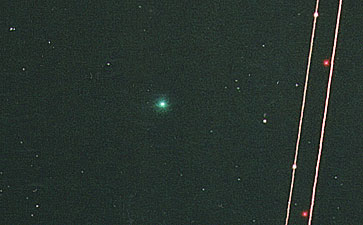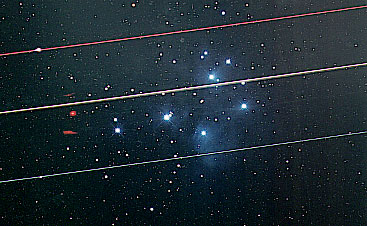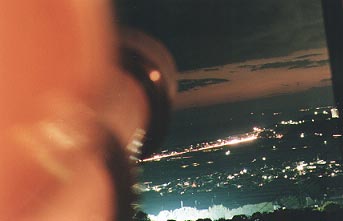
| Return |
| • February 15 The sky cleared up perfectly. Comet Ikeya-Zhang increased its brightness shining at magnitude 6.3 with a tail a little less than a degree long to the east. Unfortunately, it was in the direction of Kochi City and photographs did not show the comet well due to fogging of film. It was barely discernable. I also observed the periodic comet Finley tonight. As the Pleiades at the zenith was so beautiful, I photographed it by ε160 telescope. During the exposure a large airplane crossed the field. Geisei Obervatory is situated near Kochi Airport and planes take off toward Osaka flying over the observatory. In two frames with C/2002 C1 on airplanes' trails crossed the field. Until about 20:00 the sky provides a splendid view of trails of crossing airplanes. In the wake of a plane's flight star images will be boiling at 300x in the 20cm guide telescope. Air turbulence degrades the seeing temporarily. (The enlarged central part) |
 Comet Ikeya-Zhang and airplane trails  The Pleiades and airplane trails |
|
• February 12 • February 10 Spring comes early to Tosa (the Koch area). You feel early spring in the air once February has arrived. I left home and headed for the observatory in the evening. After 35 minutes' drive I reached Mt.Teiyama, when I saw the sunset. I drove 200 meters south off Highway 55 and watched the setting sun. The sun was seen in the direction of Cape Ashizurimisaki, where you can sometimes see the well-known phenomenon in which the sun appears as two disks; sitting on top of each other but overlapping at the contact point just like the shape of a Japanese Dharma doll. Even mirages were seen many years ago, they say. Everything was painted red; it was such a beautiful evening that you would see only in your dreams. |
 |
| I planned to observe Comet Finley in the western sky. Mr. Ikeya had just discovered C/2002 C1. Look at light pollution in the western sky seen from the dome where the 60cm reflector is housed. The bright glow closer to us is from a night baseball game. The lines of lights in the distance are headlights of moving cars along Highway 55. The lights for horticultural greenhouses, Gesiei's pride, are not turned on yet. Over a period of 20 years, the observatory "at the darkest site" has changed to the one "at the brightest" in Japan. |
 |
Copyright (C) 2002 Tsutomu Seki.